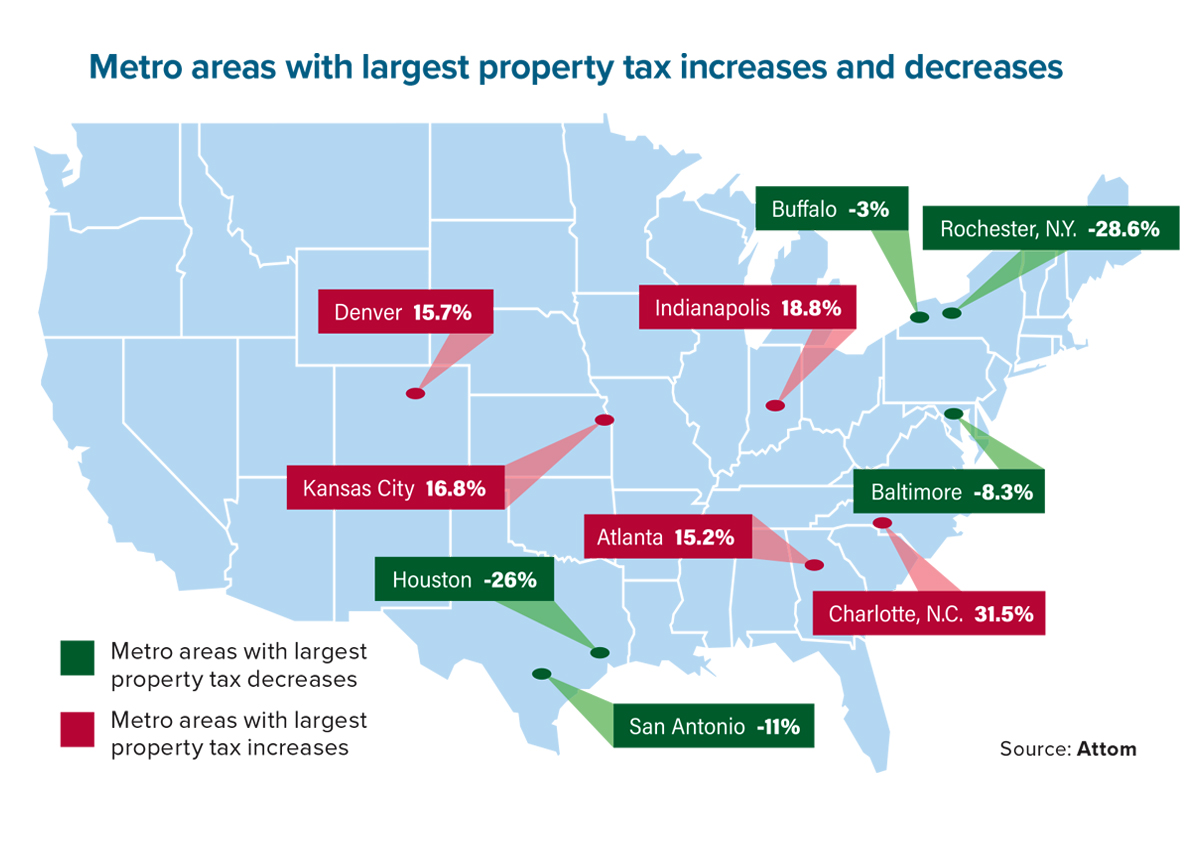In 2023, $363.3 billion in property taxes were levied on single-family homes, according to Attom’s 2023 property tax analysis of 89.4 million U.S. homes. That tax total represents a 6.9% increase from 2022’s $339.8 billion, and it is almost double the 3.6% growth rate seen in 2022. It marks the largest growth rate in the past five years, despite overall home values starting to decline.
The average tax on single-family homes in the U.S. rose to $4,062 last year, a 4.1% increase that comes after a 3% increase in 2022. The increase in average tax resulted in the first increase in the effective tax rate nationwide since 2017. (The effective tax rate reflects the average annual property tax expressed as a percentage of the average estimated market value of homes in each geographic area.) The effective tax rate nationwide in 2023 was 0.87%, up from 0.83% in 2022.
The combination of increasing property taxes and declining home values led to effective rates increasing across the U.S. last year. The average home value nationwide dropped 1.7% in 2023, as the housing market boom started to cool off after a decade of growth. Tax rate increases are likely due to inflationary pressures on the cost of operating local governments and schools, in addition to rising wages for public employees, but as with anything relating to real estate, tax rates vary widely by locale.
The highest effective property tax rates in 2023 were seen in the Northeast and the Midwest. Illinois led the top 10 states with an effective property tax rate of 1.88%, followed by New Jersey (1.64%); Connecticut (1.54%); New York (1.46%); Nebraska (1.46%); Ohio (1.37%); Pennsylvania (1.33%); Vermont (1.29%); Kansas (1.26%); and New Hampshire (1.25%).
On the other side of the spectrum, the South and the West led the way with the lowest effective property tax rates. Hawaii had the lowest effective property tax rate last year with just 0.31%, followed by: Arizona (0.41%); Alabama (0.42%); Delaware (0.43%); Tennessee (0.44%); Idaho (0.44%); Utah (0.45%); Nevada (0.48%); Colorado (0.48%); and West Virginia (0.49%).
While average property taxes increased by 4.1% nationwide last year, more than 50% of the metro areas analyzed by the report saw even higher increases. Among metros with a population of at least 1 million, Charlotte, N.C., led the way with a whopping 31.5% increase, followed by: Indianapolis (up 18.8%); Kansas City (up 16.8%); Denver, (up 15.7%); and Atlanta (up 15.2%).
Those numbers were balanced on the other side with some significant declines in average property taxes elsewhere. The largest decreases included: Rochester, N.Y. (down 28.6%); Houston (down 26%); San Antonio (down 11%); Baltimore (down 8.3%); and Buffalo (down 3%).
The largest and most desirable metro areas continue to be, unsurprisingly, the most expensive in terms of effective tax rates and average property tax. But according to the report, just 21 of the 1,502 U.S. counties with at least 10,000 single-family homes had an average property tax of more than $10,000. The New York City area accounted for 12 of those counties, and three of the top five counties with the highest property taxes; the other two in the top five were San Mateo County (near San Francisco) and Santa Clara County (San Jose), both in California.
As home values and mortgage rates fluctuate and reflect larger economic movements, property tax rates will continue to be a factor for homeowners and homebuyers. Effective tax rates will bear close scrutiny this year, as the real estate industry waits to see if the market rebounds. If home mortgage rates match recent drop-offs (or decline further) and the tight supply of homes continues, it’s likely that prices will increase again. Only time will tell if those values will outpace tax increases and lower effective rates, or if home prices will stagnate and effective rates will increase further. ●
Author
-

Rob Barber is CEO at Attom, a leading curator of land, property data, and real estate analytics for more than 155 million U.S. residential and commercial properties. He leads teams that diversify the business, improve the quality of revenue and generate returns for investors. He previously served as CEO of Environmental Data Resources, where he helped to scale the company from a niche data publisher into the nation’s largest transaction and business intelligence platform for commercial real estate due diligence. Learn more about Attom at attomdata.com.
View all posts






